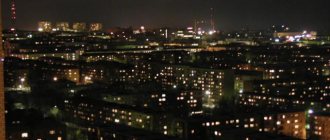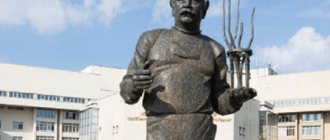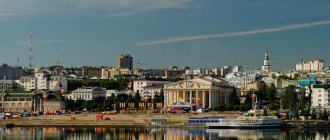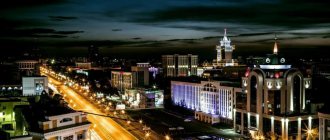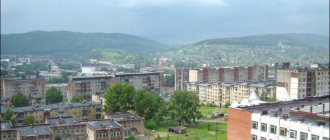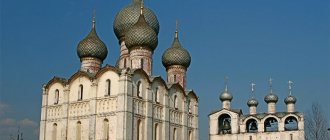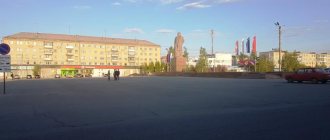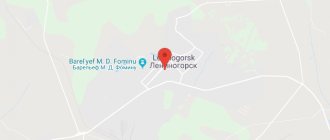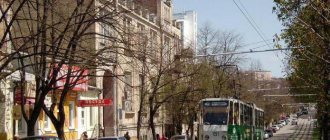Year of foundation: 1760
City Day is celebrated
on June 12
.
Izhevsk arms factory
Izhevsk
- a Russian city, the capital of the Udmurt Republic, located near the confluence of the Izh River and the Kama. It is one of the twenty largest cities in the country.
Izhevsk
appeared as a village at the Izhevsk ironworks and
was founded
on April 10, 1760 by A.S. Moskvin.
In 1774 it was captured by Pugachev's army and severely destroyed.
The city was reborn in 1807. Entrepreneur A.F. Deryabin is building an arms factory, and a village is growing again nearby. By the end of the 19th century, the village surpassed the surrounding cities in the number of residents. There are two gymnasiums, a theater, a library, a printing house, a telegraph office, a power plant, and a cinema here. In 1885, mass production of hunting rifles began. 1891 - three-line rifle S.I. Mosin. It was in Izhevsk that all its varieties were produced (infantry, dragoon, Cossack, training).
On October 27, 1917, Soviet power was proclaimed in Izhevsk. In 1918, by the decision of deputies of the Izhevsk Council, the Izhevsk plant was transformed into a city. On August 8, 1918, a massive anti-Bolshevik uprising occurred. Soon the army of A.V. Kolchak captures the city. After a retaliatory assault on the city by Red Army divisions in June 1919, most gunsmiths fled to Siberia.
In 1921, Izhevsk became the center of Udmurtia. On December 28, 1934, Izhevsk acquired the status of the capital of the UASSR.
In 1948, an experimental industrial series of the Kalashnikov AK-47 assault rifle was produced. In December 1966, the first Izhevsk car was produced.
Izhevsk was renamed the city of Ustinov on December 27, 1984, in order to perpetuate the memory of D.F. Ustinova. The historical name was returned to Izhevsk on June 19, 1987.
Modern Izhevsk is famous for the production of high-quality steel, developed mechanical engineering, production of cars, motorcycles, small hunting and rifled weapons; instrument making, food processing industry.
By Decree of the President of the Russian Federation dated July 2, 2022, Izhevsk was awarded the honorary title of Russian Federation for the significant contribution of city residents to achieving Victory in the Great Patriotic War of 1941–1945, ensuring uninterrupted production of military and civilian products at industrial enterprises, and for the massive labor heroism and dedication shown. Federation " City of Labor Valor"
».
St. Michael's Cathedral It is interesting to see the sights
of Izhevsk associated with its weapons glory - the museum and exhibition complex of small arms named after M.T. Kalashnikov. As well as architectural objects - St. Michael's Cathedral, Alexander Nevsky Cathedral, National Museum of the Udmurt Republic.
curious
the origin of the humorous nickname for the gunsmiths of Izhevsk (because of the green caftans that were awarded to them for special successes).
More than 646 thousand people live in the city (as of 2022).
Official birthday of the city
Izhevsk is considered June 10, 1921. In 1988, Izhevsk held a citywide holiday on this day for the first time. Since then, the holiday has become an annual event, but since 1992 it has been combined with the celebration of Russia Day and began to be celebrated on June 12.
Izhevsk
Video: Izhevsk
Basic moments
Izhevsk from a bird's eye view
Izhevsk stands between the Kama and Vyatka, on the Izh River, which divides it into two parts. The city is located 1200 km from Moscow and lives according to Samara time. The day comes here an hour earlier than in the capital of Russia. Streets and houses were built on a hilly plain, and the features of the relief were reflected in the old names of Izhevsk districts and streets - Gorka, Malinovaya Gora, Nagorny and Zareka. The highest place of the Udmurt capital is in the Eastern village (208 m), and the southern part of the urban area lies in the lowlands.
The historical center of Izhevsk was formed around former state-owned factories. You can come here by different types of public transport, but the most convenient way to do this is by tram number 11. The main architectural monuments and museums of the city are associated with the production of small arms. This is a monument to Izhevsk gunsmiths, a museum of the history of OJSC Izhmash, as well as a museum and exhibition complex of small arms, which bears the name of Mikhail Timofeevich Kalashnikov.
Monument to Izhevsk gunsmiths
Monument to Peoples' Friendship
The city has many beautiful temples, unusual monuments, interesting museums and pleasant green areas for walking. Tourists who come here try to take away weapons-themed souvenirs as a souvenir of their stay in Izhevsk. Patterned woolen socks and mittens, dolls in national Udmurt costumes and paintings by local artists are also popular among travelers.
Lenin Street in Izhevsk
Tower of the Main Building of Izhevsk)
East Street
Likhvintseva Street
Gorkogo Street
History of Izhevsk
The first settlements on the site where the arms capital of Russia later grew appeared in the 3rd-5th centuries. These were fortified settlements typical of the early Middle Ages, in which houses were protected from the enemy by earthen ditches, ramparts and high log walls. In addition, archaeologists discovered several burials on the territory of the city dating back to the 5th-6th centuries.
In the Middle Ages it was part of the powerful Kazan Khanate, and after the fall of Kazan the Udmurts joined Russia (1558). Then the lands on both banks of the Izh River, by decree of Ivan the Terrible, began to belong to the Tatar princely family of the Yaushevs.
Gunsmiths of the Izhevsk plant. 1880s
In the 1730s, rich deposits of iron ore were discovered on the right bank of the Kushva River, and several state-owned factories appeared for its extraction and processing. The deposits turned out to be so rich that the built capacities were clearly not enough.
The Russian Empress Elizaveta Petrovna ordered the opening of three more factories in the Kama region. Thus, thanks to the development of metallurgical production, the Izhevsk ironworks and the adjacent settlement were founded in 1760. Three years later, a dam was built on the river, and a large Izhevsky pond appeared.
At the same time, the first metal was produced at the plant. Local steel was obtained by melting cast iron, which was brought from other factories near the Urals. At first, bars and strips were made in Izhevsk, and then they began to cast iron gratings and anchors.
Bazarnaya Street (now Gorky Street), 1918
In 1774, the plant suffered great damage from the Pugachev uprising. Emelyan Pugachev's associates captured the village, executed the management and ruined the production. When the popular uprising was suppressed, the plant was restored.
At the beginning of the 19th century, firearms and bladed weapons began to be produced here. To help in mastering new technologies, many specialists from Germany, Sweden and Denmark came to the plant, and along with Izhevsk workers, craftsmen from other Russian arms factories worked in the workshops. In addition to weapons, the city mastered the production of tools, and at the end of the 19th century, steel foundry and rolling production appeared here. The plant began to fulfill not only military orders, but also made hunting rifles.
In 1934, the city became the capital of Udmurtia, and the change in status greatly affected its development. Over several decades, the population of Izhevsk has grown 10 times. The city quickly developed and expanded to include the surrounding villages.
Supreme Court of the Udmurt Republic
Residence of the Head of the Udmurt Republic
Sights of Izhevsk
In the city center, at 222 Karl Marx Street, stands the majestic Cathedral of the Archangel Michael. The beautiful red and white temple was built in 1907. During the years of Soviet power it was destroyed, and in 2006 it was restored by the decision of the townspeople. The temple rises to a height of 67 m. It stands on a hill, which offers excellent views of different areas of Izhevsk. And next to the cathedral is the picturesque Church of the Kazan Icon of the Mother of God.
Izhevsk at night
At the busy intersection of Udmurtskaya and Troitskaya streets you can see another cathedral - the Holy Trinity. The Orthodox church was erected in 1812-1814 on the site of a dilapidated wooden church. Today this cathedral is active.
Izhevsk Alexander Nevsky Cathedral (M. Gorky St., 86) has the status of a cathedral church. The temple in the style of Russian classicism was built in 1823 according to the design of the factory architect S. E. Dudin. A year later, the cathedral was visited by Russian Emperor Alexander I, who donated money for its construction. For a long time, the cathedral served as the urban center of Izhevsk and forms a harmonious architectural ensemble with the main building of the arms factory.
10 km from the Udmurt capital, in the village of Ludorvai, there is an ethnographic museum-reserve, occupying an area of 40 hectares. People come here to get acquainted with the life and culture of the indigenous people of the republic. There are many authentic buildings in the reserve - houses, estates and windmills, and folk craft master classes are held here for guests. Travelers who come to Ludorvai can ride a horse, go to a Russian bathhouse and taste national Udmurt dishes. The reserve is open to visitors on weekdays: from October to April from 11.00 to 15.00, from May to September from 10.00 to 18.00.
Sculpture of the wolf Akela at the entrance to the Izhevsk Zoo
Those who are tired of the city noise should take a walk along the picturesque embankment of Izhevsky Pond or along the Central Square, which is located near the Eternal Flame. A quiet park area is also located on Militsionnaya Street, on the shore of Izhevsky Pond. This is the spacious Summer Garden of Maxim Gorky, created back in 1857. Today, the Summer Garden has become an excellent city park with walking paths, shady alleys, fountains, cozy cafes and attractions for children.
Travelers with children love to stop by the Izhevsk Zoo (Kirova St., 8). All tourists who have visited here note its clean and well-groomed territory. The creators of the zoo not only comfortably accommodated the animals, but also created for them an environment that was as close as possible to their natural habitat. Today the zoo houses about 400 animals. It is open every day except Monday: in summer from 10.00 to 19.00, and in winter from 10.00 to 16.00.
Philadelphia Church
The old building of the Izhevsk Cathedral Mosque
Museums
On Borodina Street, 19, there is an interesting museum and exhibition complex named after M. T. Kalashnikov. This is one of the most visited museums in the city, attracting many tourists all year round. They can look at unique samples of weapons and documents telling about the Kalashnikov family, and also shoot with a machine gun at the shooting range. The museum is open to visitors from 11.00 to 19.00, and on weekends – until 17.00.
Another “weapons” museum is located on Sverdlova Street, 32. It reveals the history of the Izhevsk Armory). The exhibition displays samples of weapons and equipment that were made in the past and continue to be produced at this enterprise today.
To better learn about the traditions of the Udmurts, as well as how Izhevsk was built, it is worth taking a look at the National Museum of the Udmurt Republic. Its exhibitions occupy the large and beautiful Arsenal building at 287 Kommunarov Street, which has the status of an architectural monument of the 19th century. The museum is named after the poet Kuzebay Gerd. In its halls you can see bladed weapons and firearms, national Udmurt costumes, peasant household items, rare photographs and documents. The museum is open to visitors on all days except Monday: from Tuesday to Sunday from 10.00 to 18.00, and on Thursdays from 13.00 to 21.00.
The work of the republic's artists is presented in the Museum of Fine Arts (Kirova St., 128). Its halls contain 11 thousand exhibits - paintings, graphic works and sculptures. The museum welcomes visitors on all days except Sunday and Monday, from 10.00 to 18.00.
In the old school building, built in 1810, a center for arts and crafts and crafts was opened (V. Sivkov St., 173). This is an ethnographic and artistic exhibition where a variety of products of Udmurt craftsmen are exhibited - ceramics, as well as products made of wood, straw, glass and metal. It is noteworthy that here you can not only look at crafts, but also buy the works you like.
Unusual monuments
Izhevsk is famous for its unusual monuments. On the spacious Gunsmith Square stands the St. Michael's Column. The monument was erected in honor of the younger brother of the Russian Emperor Alexander I, Mikhail Pavlovich Romanov, who headed the Artillery Department and oversaw the work of the arms factory in Izhevsk.
Since 2010, on the edge of the Central Square, Izhik, a favorite of townspeople and tourists, has been installed - a little man in a gunsmith’s caftan. He is considered one of the symbols of the city, and there is a tradition of rubbing Izhik’s nose “for good luck.” It is not difficult to guess that the shiny metal nose is visible from afar.
At the intersection of Kommunarov and Sovetskaya streets there is a cast-iron allegory monument made in the postmodern style. A human-like crocodile sits imposingly on a cast-iron bench. Before the revolution of 1917, the artisans of the Izhevsk arms factory received the title of “kaftan workers.” At the same time, they were awarded a high top hat and a long-skirted caftan made of green cloth. And from the townspeople, Izhevsk artisans received the nickname “crocodiles.”
Goat monument
In the Birch Grove Park there is a monument to a goat, and therefore the park is often called “Goat Park”. About 100 years ago, there were private houses near the green area, and residents grazed goats next to them. The goat monument was built in steampunk style, using about 150 kg of scrap metal.
In March 1961, a Soviet spaceship landed in the steppes of Udmurtia, carrying the dog Zvezdochka. The animal's successful return to Earth marked a milestone for Yuri Gagarin's space flight, and as such Zvezdochka is considered a local celebrity. In the Zvezdochka park you can see a monument to the astronaut dog.
Residents of Izhevsk expressed their love for dumplings in a monument located near the Pozim cafe on Kraeva Street. A giant dumpling is impaled on a huge fork 3 meters high. It is curious that, according to one version, the word “dumpling” came into use from the Udmurt language: “pelnyan” translated means “bread ear”.
Sculpture "Dumpling"
Crocodile sculpture
Hotel deals
Booking.com
How to get there
You can fly to the weapons capital of Russia by plane. Izhevsk Airport is located 15 km east of the city center and is connected by direct flights to several Russian cities: Moscow, St. Petersburg, Sochi, Nizhny Novgorod, Kirov, Yekaterinburg, Ufa, Kazan, Anapa and Simferopol. You can get from the airport to the city by buses and taxis.
The city railway station is located at 16 Druzhby Street. About 100 trains come here every day. You can get from Moscow to Izhevsk by rail in 17 hours. From the station you can get to different parts of the city by trams, buses, minibuses and taxis.
If you wish, it is easy to come to Izhevsk by car. The road from Moscow takes about 17 hours (1200 km).
There are regular buses from some cities to Izhevsk. The capital of Udmurtia has daily bus service with Kazan, Perm, Ufa, Yekaterinburg, Naberezhnye Chelny, Nizhny Novgorod, Ulyanovsk and Yoshkar-Ola. The duration of the trip depends on the distance. On average, passengers spend 5-9 hours on the road and arrive at the central bus station of Izhevsk (Krasnoarmeyskaya St., 134).
Calendar of low prices for air tickets to Izhevsk
Location
Tourists who do not know the administrative structure of Russia well may ask the question in which region Izhevsk is located. In fact, the city, home to almost 700 thousand people, is the capital of Udmurtia. To answer the question of inquisitive travelers, where is Izhevsk, it is worth taking a look at the capital of Tatarstan, well known to tourists. Approximately 275 km separate the main city of Udmurtia from Kazan.
Izhevsk is located in a picturesque place between the Kama and Vyatka - two rivers flowing through the territory of European Russia. The distance from Izhevsk to the Russian capital is 1193 km, if you travel by road. A trip by car from Moscow lasts at least 14 hours. Motorists will be interested to know the distances from the Udmurt capital to nearby cities:
- Naberezhnye Chelny – 190 km;
- Neftekamsk – 130 km;
- Perm – 280 km;
- Kazan – 380 km.
City information
Izhevsk is the capital of the Udmurt Republic. Located between the Vyatka and Kama rivers. The economy is represented by enterprises of the metallurgical, mechanical engineering, and defense industries.
Regional roads pass through the settlement: P320, P321, P322, and the European route E22. A major highway of the Gorky Railway runs through it. There is an airport of the same name.
There are universities and their representative offices, professional and secondary specialized educational institutions. There are cultural institutions and attractions. The population is about 650 thousand people.
Climate and nature
Izhevsk is a green city, surrounded by meadows and dense mixed forests. The climate of the city, like that of the entire republic, is characterized as temperate continental. Winter is characterized by severe frosts. Summer is short and warm. Air temperature indicators at night and during the day depend on the specific month:
- January: – 14.2; – 11.8;
- February: – 13.3; – 9.3;
- March: – 7.9; – 3.0;
- April: + 1.1; + 5.6;
- May: + 9.6; + 17.6;
- June: + 13.8; + 21.9;
- July: + 15.3; + 25.4;
- August: + 14.0; + 23.8;
- September: + 8.7; + 15.4;
- October: + 1.6; + 5.0;
- November: – 4.5; – 2.5;
- December: – 10.2; – 8.5.
The first number in the list is the average temperature at night, the second is the average temperature during the day. It rains more often in the summer months, in April and September. The most sunny days are in May and summer. Calm weather is typical for July.
The city's flora is represented by 1,700 plant species. In Izhevsk and its suburbs you can see Siberian fir, Finnish spruce, bird cherry, larches, cedars and other trees and shrubs. The local forests, groves and meadows are inhabited by golden eagles, foxes, wood grouse, badgers, eagle owls, black storks, martens, orioles, moose, hawk owls and other animals and birds.
In addition to Izh, 12 rivers flow through the city. In the north-west of the Udmurt capital there is Izhevsky Pond, stretching for 11.6 km. Width – from 788 m to 2.56 km. In the south of Izhevsk there are two more small ponds: Pirogovsky and Sepychevsky.
Short story
On the territory of Izhevsk, archaeologists have discovered traces of ancient settlements, the age of which is estimated at 1800 years. From 1438 to 1552, the land on which the capital of Udmurtia later appeared belonged to the Kazan Khanate. After the capture of Kazan by the troops of Ivan IV in 1552, the Udmurt region became part of Russia. The further history of Izhevsk is marked by several fateful events:
- from 1582, the territory where the city appeared much later belonged to the Tatar volost;
- in 1734, iron ore deposits were discovered here;
- April 1760 - construction of the Izhevsk plant and the village around the enterprise began;
- 1763 – construction of a dam on the Izh River and the formation of the Izhevsk pond;
- 1774 - the plant was looted by rebels under the leadership of E. Pugachev;
- 1807 – the founding of an arms factory took place;
- XIX century - rapid development of production;
- February 1918 - the village received city status and began to be called Izhevsk;
- December 1934 - the city was given the status of the capital of an autonomous republic;
- 1940–1988 – a period of rapid development of industry in the city and expansion of its territory; 17 nearby towns and villages were annexed to Izhevsk;
- September 2010 – ceremonial events were held in the capital of Udmurtia on the occasion of the 250th anniversary of the city.
Now Izhevsk is a large industrial center, home to over 90 nationalities. The largest peoples in number are Russians (69%), Tatars (9%) and Udmurts (15%).
Famous people
The lives of many famous people are connected with Izhevsk, but, of course, the most famous of them is Mikhail Kalashnikov. His brainchild, the machine gun of the same name, can even be seen on the flags of a number of countries. Among other celebrities of the city and the republic, the following personalities can be noted:
- Pyotr Shuvalov, count, founder of the city, famous statesman of the country;
- Grigory Vereshchagin, ethnographer;
- Vladimir Korolenko, famous human rights activist;
- Dmitry Zelenin, ethnographer;
- Hermann Weber, motorcycle designer;
- Alexander Belyanin, full Knight of St. George;
- Hugo Schmeisser, small arms designer;
- Ivan Bodalev, merchant, builder and philanthropist;
- Gennady Nikonov, weapons designer;
- Lyudmila Glazova, actress;
- Valery Medvedtsev, biathlete, Olympic champion;
- Anton Sychev, swimmer;
- Ivan Tcherezov, biathlete;
- Maria Gorban, actress.
Geography
The territory in which Izhevsk is located is a flat area with low hills scattered across it. The capital of Udmurtia stretches for 27.4 km from south to north and 17.4 km from east to west. On the territory of Izhevsk – 315.5 sq. km – three cities such as Tver or Tula can fit. The capital of Udmurtia is approximately 6.5 times smaller than Moscow.
Izh, a tributary of the Kama, divides Izhevsk into two almost equal parts. The city lives according to Samara time, which is one hour ahead of Moscow. The capital of Udmurtia includes 5 urban districts. Its location in the Volga region has a beneficial effect on the economic development of the city. The republic, of which Izhevsk became the capital in 1934, borders on four constituent entities of the Russian Federation:
- with the Perm region;
- Tatarstan;
- Kirov region;
- Bashkortostan
Investments
Izhevsk is a steadily developing city, so a lot of investment projects are being implemented here in various fields of activity:
- residential construction (mainly multi-family housing);
- construction of a plant for the production of cable joints;
- reconstruction of sections of heating mains;
- reconstruction of overhead power lines;
- modernization of facilities to create production of the LADA2191 car;
- creation of production of springs with increased service life;
- expansion of steel radiator production;
- increasing the production of sporting and hunting weapons;
- creation of specialized production of gyroscopes;
- creation of lines for the production of insulating tapes and acrylic adhesive tapes;
- creation of production for anodizing aluminum profiles.
In addition, there are a number of projects that could be implemented if additional funding is found:
- expansion of paint and varnish production;
- creation of the Scientific and Production Center “Cryogenic Technologies”;
- low-rise microdistrict;
- creation of a biotesting and biomonitoring laboratory;
- remediation of solid waste landfill;
- creation of production of light-emitting diodes;
- technical re-equipment of the boiler room.
Ways to solve the problem
Naturally, there is no single solution to the problems associated with the deteriorating demographic situation, but in the conditions of Izhevsk you can take advantage of the following points.
Firstly, local authorities should focus on ideological propaganda of family values and the enormous role of motherhood in the formation of every person.
Secondly, it is necessary to improve the healthcare system, since the gradual aging of the population will inevitably lead to an increase in visits to doctors.
Thirdly, Izhevsk, whose population in Soviet times was distinguished by high scientific and industrial potential, should strive to attract people with high educational potential. The basis for this should be an increase in the level of educational services.
Sex and age structure
The population of Izhevsk can be considered as a kind of cross-section, giving an idea of the gender and age structure of the population throughout Russia. Thus, according to data at the beginning of this year, the total number of men in the city is just over forty percent, while the percentage of women is close to sixty.
The picture is not very happy if we look at the age structure of the city’s population. Despite the fact that in recent years the number of both men and women, albeit not at a very high rate, has been growing, the percentage of the working-age population in the overall structure of residents of this urban population has continued to decline. Moreover, this trend is likely to continue in the coming years. The thing is that people born in the 1950s and 1960s are gradually retiring, but very few are replacing them. This is due to the difficult situation in the country in the 1990s, when there was a real demographic crisis.
